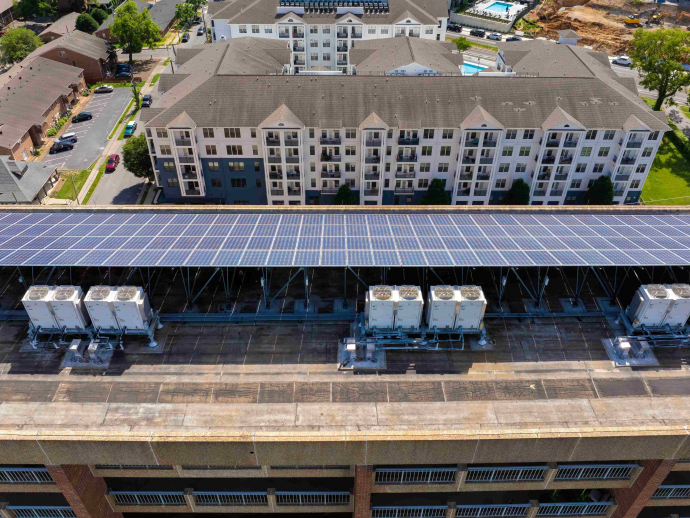Solar Installation for Multi-Tenant Buildings: Solutions and Strategies

Deploying solar energy systems on multi-tenant buildings presents a unique opportunity to enhance energy equity and sustainability. Apartment complexes, historically excluded from accessing solar energy benefits, can now leverage innovative solutions to reduce energy costs and promote environmental stewardship. This article explores the strategies and solutions for successful solar installations in multi-tenant buildings.
Overcoming Challenges in Multi-Tenant Solar Installations
Multi-tenant buildings, particularly those housing low-to-moderate income (LMI) communities, face distinct challenges in adopting solar energy. These challenges include:
-
Split-Incentive Problem: Building owners often bear the installation costs, while tenants reap most of the economic benefits.
-
Financial and Technical Barriers: Apartment owners and renters have historically lacked access to solar energy due to financial and technical limitations.
-
Diverse Interests and Needs: Managing the varied energy needs and preferences of multiple residents can be complex.
Innovative Solutions for Multi-Tenant Solar
Several strategies and technologies have emerged to address these challenges, making solar energy accessible and equitable for multi-tenant buildings:
-
Net Energy Metering Aggregation (NEMA): NEMA allows building owners to aggregate electrical loads from multiple meters and offset them with solar production fed into a single meter. This approach simplifies system sizing and eliminates the need for extra equipment.
-
Requirements: The system must be sized to the customer’s recent annual load, accounts must be on the same or adjacent properties, and all meters must be under the same name.
-
Benefits: Easier system sizing and no need for extra equipment, reducing costs.
-
-
Virtual Net Energy Metering (VNEM): VNEM enables building owners to install a single solar system to cover the electricity load of both common and tenant areas connected at the same service delivery point. Electricity does not flow directly to any tenant meter.
-
SolShare Technology: The SolShare system is designed specifically for multi-family or multi-tenant buildings, taking energy generated by a solar project and directly distributing it to individual tenants.
-
SolShare tracks the solar energy delivered to each unit, ensuring equal distribution.
-
Excess energy not used by tenants can be sold back to the utility grid.
-
The system mounts next to the PV inverter, streamlining the installation process.
-
SolShare allows tenants to monitor their energy use, while landlords can set rules for solar energy distribution.
-
-
Offsetting Common Area Usage: Solar systems can offset electricity usage in common areas like elevators, lighting, and HVAC systems. This approach benefits all building occupants equally, with costs rolled into periodic assessments or financed by the condo association.
Financial Incentives and Regulatory Support
Government incentives and regulatory frameworks play a crucial role in promoting solar adoption in multi-tenant buildings:
-
California Multi-Unit Solar Tenant Billing: CPUC Code 2868 allows owners of multi-tenant properties to generate rental income by providing tenants with discounted solar energy.
-
Title 24 California Solar Mandate: This mandate requires all newly constructed commercial and high-rise multi-family buildings to install solar PV technology and battery storage systems.
-
Federal Tax Credits: Building owners can potentially receive up to a 50% tax credit on solar installations, offsetting operating costs and creating a revenue stream.
Step-by-Step Installation Strategies
Successfully installing solar panels in multi-metered buildings involves several key steps:
-
Initial Assessment: Conduct a thorough site inspection and obtain a quotation from a certified solar installer.
-
System Design: Customize the system based on the building's energy needs, considering factors like roof space and energy consumption patterns.
-
Tenant Engagement: Communicate the benefits of solar energy to tenants and address any concerns they may have.
-
Professional Installation: Ensure the system is installed by certified professionals to guarantee efficiency and safety.
-
Ongoing Monitoring and Maintenance: Regularly monitor the system's performance and perform necessary maintenance to maximize its lifespan.
Conclusion
Solar installation for multi-tenant buildings represents a significant stride towards energy equity and sustainability. By leveraging innovative technologies, financial incentives, and strategic implementation, apartment complexes can unlock the economic and environmental benefits of solar energy, creating more resilient and eco-friendly communities. As the demand for sustainable energy solutions grows, multi-tenant solar installations will play an increasingly vital role in shaping a cleaner, more equitable energy future.
